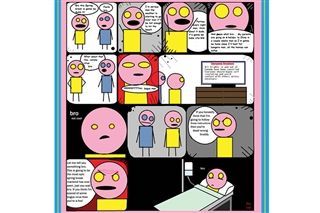The Grade 12s in IB Language and Literature had just begun studying Marjane Satrapi’s Persepolis when the world shifted under their feet. So, like Satrapi, they used the opportunities afforded by art to process and express their experiences.
The students had fun exploring a variety of comics, from online, ongoing blogs to one-off political cartoons. They also explored the surprising potential of the comic form in addressing darker and more nuanced issues. Like Art Spiegelman’s graphic novel Maus, Satrapi’s work revolves around the personal relationships and individual growth that take place against the backdrop of major historical events.
As they lived through the COVID-19 pandemic, the students set out to explore the variations in their own experiences during historic times. The students all felt a different level of connection or comfort with the events of the ongoing pandemic, so they ‘created broadly’ on the idea of ‘extraordinary times’ with an invitation to talk about the current pandemic or about survival and coping in general.
Students took different approaches to their comics including some who dug into the craft by carefully varying graphic weight and colour across an entire comic to create a shift in atmosphere, and some students played with frame-to-frame transitions in order to tell a story. Other students explored perspective by personifying the virus, and explored that by summarizing the experience of 2020 graduates. Students even used personal experiences in a carefully plotted story arc to express an uplifting theme.
In studying Satrapi’s autobiographical comic about growing up in Iran during and after the revolution, the class learned new terminology to describe and deconstruct the interaction between written and visual text. IB Language and Literature gives equal attention to literary and non-literary texts, and the graphic novel as a form affords a unique chance to consider the contributions of written versus visual storytelling in a single narrative, including what is best expressed by a pithy quotation: What is said best without words? From the emotional impact of graphic weight, to the narrative difference between captions and speech bubbles, to concepts like framing and camera angle pulled from earlier film studies, they learned to appreciate the complexity of seemingly simple drawings.
Across all subjects, IB is a program that values learning-through-doing, so applying these newly mastered concepts to their own stories was an obvious next step. The resulting comics showed an exciting range of experimentation by the graduating class. Some have explored perspective by personifying the virus or summarizing the experience of 2020 graduates. Some have dug into the craft of comics more specifically, playing with frame-to-frame transitions in order to tell the story, or carefully varying graphic weight and colour across a whole comic to create a shift in atmosphere. Still, others have taken their personal stories and, through carefully plotted story arcs, crafted uplifting and hopeful messages to share with their audiences. In every case, the graduating class has showcased their talent and grit, completing valuable and creative work to that they can celebrate as they end their classes online.





